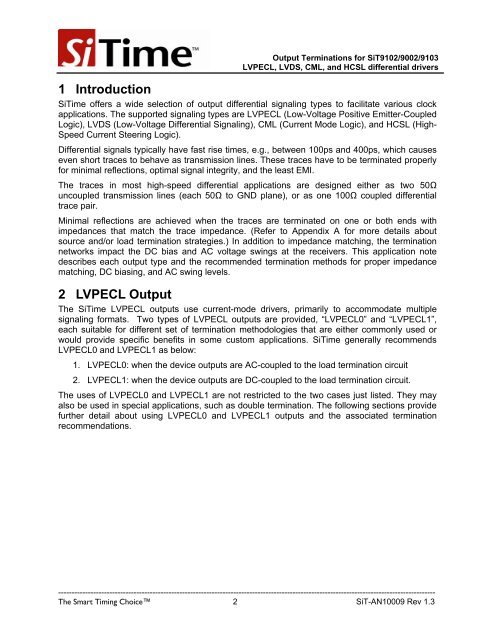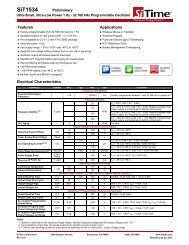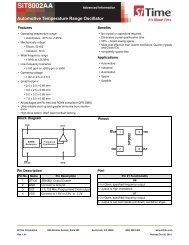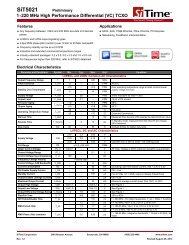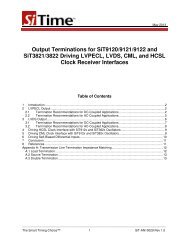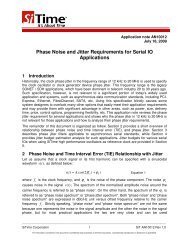Differential Output Terminations LVPECL, HCSL, LVDS ... - SiTime
Differential Output Terminations LVPECL, HCSL, LVDS ... - SiTime
Differential Output Terminations LVPECL, HCSL, LVDS ... - SiTime
- No tags were found...
You also want an ePaper? Increase the reach of your titles
YUMPU automatically turns print PDFs into web optimized ePapers that Google loves.
<strong>Output</strong> <strong>Terminations</strong> for SiT9102/9002/9103<strong>LVPECL</strong>, <strong>LVDS</strong>, CML, and <strong>HCSL</strong> differential drivers1 Introduction<strong>SiTime</strong> offers a wide selection of output differential signaling types to facilitate various clockapplications. The supported signaling types are <strong>LVPECL</strong> (Low-Voltage Positive Emitter-CoupledLogic), <strong>LVDS</strong> (Low-Voltage <strong>Differential</strong> Signaling), CML (Current Mode Logic), and <strong>HCSL</strong> (High-Speed Current Steering Logic).<strong>Differential</strong> signals typically have fast rise times, e.g., between 100ps and 400ps, which causeseven short traces to behave as transmission lines. These traces have to be terminated properlyfor minimal reflections, optimal signal integrity, and the least EMI.The traces in most high-speed differential applications are designed either as two 50Ωuncoupled transmission lines (each 50Ω to GND plane), or as one 100Ω coupled differentialtrace pair.Minimal reflections are achieved when the traces are terminated on one or both ends withimpedances that match the trace impedance. (Refer to Appendix A for more details aboutsource and/or load termination strategies.) In addition to impedance matching, the terminationnetworks impact the DC bias and AC voltage swings at the receivers. This application notedescribes each output type and the recommended termination methods for proper impedancematching, DC biasing, and AC swing levels.2 <strong>LVPECL</strong> <strong>Output</strong>The <strong>SiTime</strong> <strong>LVPECL</strong> outputs use current-mode drivers, primarily to accommodate multiplesignaling formats. Two types of <strong>LVPECL</strong> outputs are provided, “<strong>LVPECL</strong>0” and “<strong>LVPECL</strong>1”,each suitable for different set of termination methodologies that are either commonly used orwould provide specific benefits in some custom applications. <strong>SiTime</strong> generally recommends<strong>LVPECL</strong>0 and <strong>LVPECL</strong>1 as below:1. <strong>LVPECL</strong>0: when the device outputs are AC-coupled to the load termination circuit2. <strong>LVPECL</strong>1: when the device outputs are DC-coupled to the load termination circuit.The uses of <strong>LVPECL</strong>0 and <strong>LVPECL</strong>1 are not restricted to the two cases just listed. They mayalso be used in special applications, such as double termination. The following sections providefurther detail about using <strong>LVPECL</strong>0 and <strong>LVPECL</strong>1 outputs and the associated terminationrecommendations.--------------------------------------------------------------------------------------------------------------------------------------------The Smart Timing Choice 2 SiT-AN10009 Rev 1.3


